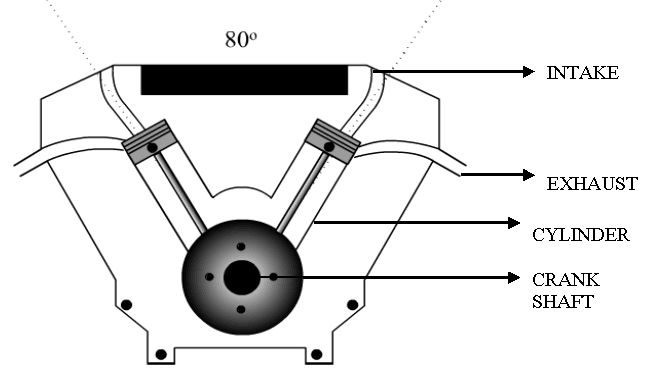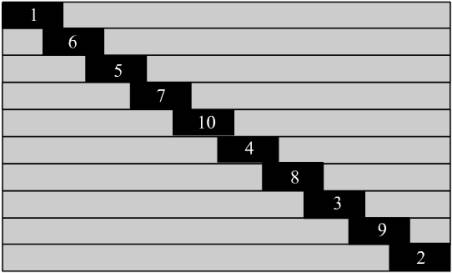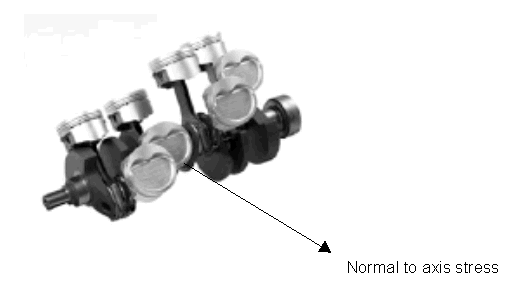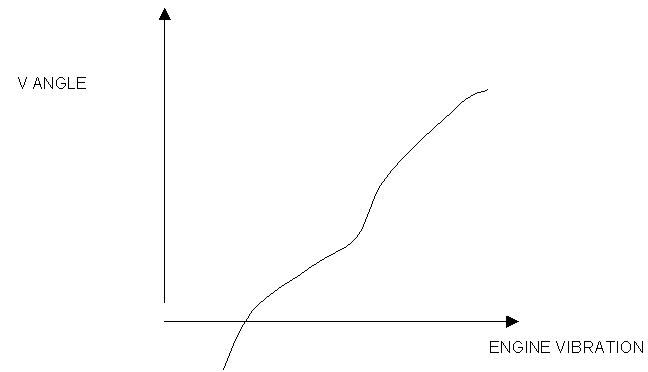
As
the current rate of development, engines would get more and more
powerful. To restrict this, the FIA lays strict rules to restrict
the maximum engine capacity to 3 liters and the number of cylinders
to 10 in V format. It is up to the teams to work under this
criterion and squeeze in as much power into the 3 liter powerplant
as they can. The ultimate performance of the car is finally a
product of the work done by the team as is seen from the fact that
Minardi are able to produce only 750 bhp compared to 900 bhp of the
Williams.
So…
we know that Formula1 cars use V10 engines. We have heard the term V
angle so often. But what exactly do these things mean? How do they
decide on the V angle? Why do some engines run a lower V angle while
some others run a higher one? What are the effects and implications
of each case? These are some of the questions this article
addresses.
Basically V angle can be defined as the angle made by the cylinders constituting the V. Each arm of the V is referred to as a ‘bank’ of cylinders. By using V angled engines, the size of the engine, compared to it’s in line equivalent is reduced by half. The use of V modeled engines necessitates the use of dual overhead camshafts, one for operating each bank. It also gives rise to two exhaust ports, again, one for each bank as you can see on any modern F1 car. What you can also see is a blowout of a single bank of cylinders indicated by concentrated exhaust from one of the exhaust ports. It also requires two sets of intake ram pipes and fuel injection lines, one for each bank. The cross sectional view of a typical V angled engine is shown below:
|
Cross section view of a typical V angled engine |
DESIGN
ISSUES :
As
already mentioned earlier, V engines require twin over head cam
shafts to operate the valves. Each of these camshafts is driven by
belts connected to the crank shaft through a set of reduction gears.
The main design consideration herein, is the realization of the
timings of the intake, power and exhaust strokes of the 10
cylinders. For continuous power delivery, it is evident that at all
times at least a few cylinders should be in the power mode. During
this period, the cylinders that have already completed their power
stroke will be in exhaust mode. Hence, the engineer first decides
which cylinders he groups as a unit.
Once this is decided, he has to position the cams on the shaft in such a way that the requirements are met to each of the cylinders. For example, if cylinders 1,3,5 and 7 are in intake mode, the cams above the intake valves of these cylinders should allow fuel entry into these cylinders. Similarly, for those cylinders in the exhaust mode, the cams above them should open the corresponding exhaust valves. The design of the timing belt is another factor of prime importance. This determines the correct instant when the valves should operate. Another factor to be dealt with is the ignition sequence which determines the sequence of firing of the spark plugs responsible for burning the gas. A typical sequencing of ignition is shown in a table format:
|
Sequencing of Ignition |
As
shown above, an F1 engine is always developing power. The power
bands of at least two cylinders are made to overlap to ensure this.
Further advancements in engine technology allow more overlapping of
power bands to improve power.
DID
YOU
KNOW: There are around 8 – 12 million ignitions in an F1 engine
over an average race distance?
In
reality, the angle of V used in engines has only little influence on
the power produced. This is due to modern techniques that are used
in the crank shaft design. The crank shaft is the instrumental part
in the performance of the engine. A simple crank shaft is shown
below
|
V Engine crank shaft |
The
above shown piston – crank shaft arrangement is from a V8 engine.
It is evident from the ‘V’ structure that considerable
normal-to-axis stress is applied to the crank shaft. The stress
applied increases with increasing V angle. To compromise this more
durable and heavy counter balancer and webbed crank pin counter
weights have to be used. This involves more reliability issues and
also increases the weight of the engine slightly. But the most
important effect of increased V angle is the engine vibration. With
more V angle, the stresses on various members increases, which
increases the vibrations, even with the use of balancer shafts.
|
Comparison between V Angles and Engine Vibrations |
With
the advent of modern fuel injection systems, supply of fuel to the
cylinders is not a problem, though the design of ram pipes may pose
a slightly more difficult issue as the wider the cylinders are
apart, the more difficult it is to feed them due to the ‘cross’
nature of the air flow directions. The supply of oil also becomes
more complicated with increasing V angle. This is because the oil
routing has to cover a wider area. Another major problem with wide
angled V engines is the engine acoustics. This does not refer to the
noises or sounds of the engine, but rather to the complex patterns
of air and vapor flow in and around the engine. For maximum
performance, these acoustic effects should cancel out. The wider the
cylinders are, the more difficult it is to do this.
So,
why do teams use wide angled engines still? They are noisy, they
produce more vibration, they involve extreme design in several
areas, and they pose a difficulty to enhance power….
Well,
there are basically two factors that make teams use the wide angled
engines. The first one is reduced centre of gravity and the second
is improved aerodynamics. The low centre of gravity s a direct
result of the fact that the engine height is low (due to high V
angle) and hence can be seated very low on the car. This allows for
better weight distribution and hence the handling is improved to a
great extent (Compare Jarno Trulli’s onboard Friday qualifying lap
at Indianapolis to anyone else’s and you’ll know what I am
talking about).
As
for the improved aerodynamics, again, as the engine sits so low, the
rear engine cover is also low. This allows the engineers to have
more design options regarding the flow of exhaust gases into the
outside and also air flow over the rear wings. On the other hand,
lower V angled engines are taller and hence have to contend with
more constraints in their rear wing and rear aero parts design.
DID
YOU
KNOW: The exhaust gases of a Formula1 car exit the outlet at speeds
in excess of 500 mph?
So
did Renault make the right decision to ditch the wide angled V 10
that has put them into contention in 2003 and go in for a lower V
design? Well, that’s a question the Renault engineers are better
equipped to decide. So lets just leave it to them.


